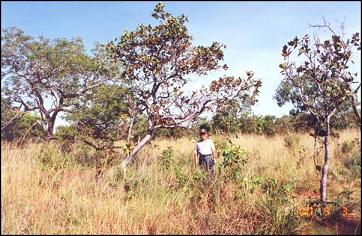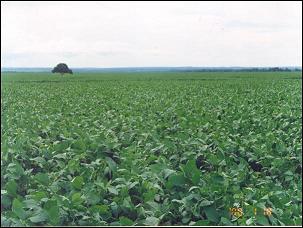Transformed Brazil as a Large Agricultural Country
2011.02.08
Rediscovering Japan's Assistance behind Brazil's Transformation to an Agricultural Giant: JICA-RI to Release Book on its Miraculous History
“The barren land.” That was how Cerrado, a tropical savanna in the Brazil's mid-west, was once so called. Yet only a quarter of a century after the Brazilian government undertook the development of the area, this infertile land has transformed into the largest agricultural region in the southern hemisphere. Cerrado's success is praised as one of the greatest achievements in agricultural history in the 20th century, but what’s not known is the role Japan's assistance and Japanese immigrants played behind the scenes.
JICA Visiting Senior Advisor Yutaka Hongo, who has been involved in the development of Cerrado for 17 years, spoke about his long-held passion. "The total area of Cerrado is 5.5 times larger than entire Japan. In the 1970s, no one could even imagine that such vast barren land would one day transform into an agricultural region. I have been strongly interested in who made the first breakthrough possible and when and how it was done."
Appreciation for Two Decades of Japanese Assistance
Among all the ODA programs that JICA has been involved in, its cooperation for the Brazil-led agricultural development of Cerrado is unparalleled. Extensive technical and financial assistance was provided. Especially, the financial assistance under "Japan-Brazil Agricultural Development Cooperation Program (PRODECER)" continued for about 20 years at a total cost of 68.4 billion yen (financed by both governments). Many Japanese-Brazilians participated in the forefront of development, stepping into the region and putting every effort as pioneers. After overcoming various difficulties over the years, they now own fields of soybean and corn that extend for miles.
JICA-RI is currently preparing a book on the achievements of Cerrado's development with a focus on its less-known history as part of the "Project History" research series. The book will be written by JICA-RI Akio Hosono and Yutaka Hongo, both experts on Latin America. In January 2011, they visited Brasilia and Belo Horizonte, the state capital of Minas Gerais, as well as Japanese colonies and interviewed about 40 people who were the leading figures in the development. They asked the interviewees to share the contexts of the time, tales of hardship, and future prospects of the region.
Of all the interviews, the most striking was the one with former Minister of Agriculture Alysson Paulinelli, who was the leader of the development projects in the 1970s. "He mentioned how they appreciated Japan's assistance and Brazil was able to expand the Cerrado development thanks to Japan," says Hosono. "This shows the fact that Japan's cooperation contributed to the development of agriculture in Cerrado. His words carry great weight, considering they come from a man who was awarded the 'World Food Prize' for his efforts in Cerrado agriculture," he adds, mentioning the prestigious international award for contributors to the world food supply.

The vegetation of Cerrado (tropical savanna)
Photo: Yutaka Hongo
Soybean: The Driving Force behind Cerrado Development
Countless people poured their hearts into the development of Cerrado. Plinio Souza of the Agricultural Research Center for the Cerrado (CPAC) was one of them and accomplished outstanding achievements in the field of agricultural science. The soil of Cerrado is strongly acidic and contains high concentration of aluminum, which hampers vegetation. It is unsuitable for agricultural production if left the way it is. Hongo says, "The only possible types of agriculture at the time were a couple of small scale farmers along the rivers engaging in self-sufficient agriculture, or major landowners grazing cattle in the plains. No one thought it was possible to operate modern agriculture in that area."
With the accumulation of research on Cerrado's natural environment, attempts were made to introduce various crops such as grains and vegetables as well as planting trees. The Brazilian government established the CPAC near the capital Brasilia in 1975, and two years later Japan started a large-scale technical cooperation program for the research center.
Soybean is originally a temperate crop from China and does not properly grow in the tropics, but became the driving force behind the Cerrado's agricultural development. CPAC’s Souza succeeded in breeding "DOKO," a new tropical variety of soybean that is fit for the region. It was named after the late Toshio Doko, Chairman of the Federation of Economic Organizations from 1974-1980, who was devoted to Japanese-Brazilian economic cooperation. "Various crops were tested, but corn did not grow on infertile soils and rice was destroyed by rice blast and droughts. Meanwhile, soybean can grow on a relatively infertile land with little soil improvement and also functions as a fertilizer. It was basically a kill-two-birds-with-one-stone solution," says Hongo. Soybean production spread rapidly as pioneer crop of Cerrado's agricultural development. Its volume shot up from none in the 1970s to 29 million tons in 2002, more than seven times the amount of Japan's soybean demand. This amounts to 58% of Brazil's soybean production, and takes up 13% of the world’s total volume.

Cerrado transformed into a vast soybean field.
Photo:Yutaka Hongo
The expansion of soybean production led to the advancement of oil mills, and also poultry and hog farmers who were to use soybean meals (residue created from the process of oil production) as livestock feed. Cerrado has now become a major base which covers the entire supply chain of soybean production. Soon after, its agriculture expanded to a diversity of other crops such as corn, cotton, coffee, and vegetables, as well as livestock farming.
Japanese Immigrants Led Cerrado Breakthrough
Interviews with farmers revealed why they chose to take such great risks to be involved in the Cerrado development at the dawn of its agriculture. Japanese immigrants to Brazil mainly settled in the states of São Paulo and Paraná in the southern region and started small-scale farms of coffee and vegetables. The land situation became a problem for the immigrants’ second and third sons when most of the land in the southern region was cultivated, not leaving enough for them to become independent. It was then the Cerrado savanna emerged as an interest for agricultural development.
At the time, an agricultural cooperative, the largest of its kind in the country, was called "Cotia Industrial Cooperation" in São Paulo, and its main members were Japanese-Brazilians. Cotia developed various lands for colonies throughout Brazil to provide cooperative members’ children with their starter farms. One of the development efforts was PADAP (Programa de Assentamento Dirigido do Alto Paranaíba), which was jointly conducted with the state government of Minas Gerais. PADAP was a ground-breaking project that set the Cerrado Agricultural Development Program off to a good start. More than 90 of Japanese immigrants’ second and third sons settled in this area.
However, there was an enormous risk for the settlers. Even if they were well-prepared to face difficulties, there was no guarantee for future business prospects. Hongo says, "They had enough passion and agricultural knowledge. But it is not hard to imagine their hardships in a time when there was no prior research done on Cerrado agriculture. How were they able to take such risks? No one would, unless they had some kind of "conviction" or "support system." I would like to focus on this point and uncover the answers to these questions."
From Cerrado to "Tropical Savannah Agriculture Development Program" in Africa
Now Cerrado’s land stretches for acres and acres, and it became crucial to find efficient means to promote areal expansion in its development. Here, a cooperative-led land reclamation system played a key role. Cooperatives led the development of many tens of thousands of hectares of settlements throughout the region under the support of the government. When settlements got on track, new agricultural producers moved in to the surrounding areas. In this way, the Cerrado development expanded further.
PRODECER, the Japan-Brazil project that was launched in 1979, began to operate this cooperative-led land reclamation program in seven states within Cerrado. Two countries established a joint corporation CAMPO (Companhia de Promoção Agrícola) for the implementation and progress management of the projects. CAMPO invented innovative environmental conservation methods such as maintenance of natural forest reserve commonly known as "condominium" in each settlement.
Hosono says, "Japan's cooperation contributed to promoting technological innovations like improvement of soils and breeds, and institutional innovations like cooperative-led land development. I believe this led to the breakthrough and ultimately triggered the miraculous success of the Cerrado development program." Japan's support for the program was completed in 2001. Yet the development itself continues till this day. Additionally, Brazil has teamed up with Japan to assist the tropical savanna agricultural development program "PRO-SAVANA" in Mozambique. Brazil will now provide knowledge from its experience in the agricultural development of Cerrado, as a donor this time.
Commentary:
Background of Japan-Brazil Agricultural Development Cooperation Program
The name "Cerrado" is from a Portuguese term for "closed." It was named for its inaccessibility due to scattered shrubs and bushes that are rarely seen in other plains. In 1959, this former wasteland drew attention when ecologist Mario Guimarães Ferri and his team at the University of São Paulo identified the reason for Cerrado's poor vegetation—it was not the lack of rainfall, but rather the quality of its soils was the problem. This discovery certified Cerrado's agricultural potential from a scientific standpoint.
But why, in the first place, did Brazil and Japan set out on this extraordinary journey to develop Cerrado? In fact, both countries were in grave situations at the time which drove them to tackle the program.
Surprisingly, Brazil used to import agricultural produce from the 1960s to the early 1970s, with zero soy bean export. Wheat was also 100% imported from overseas. Agricultural expansion was a dream, as well as a pressing problem for the Brazilian government. However, room for agricultural expansion in the southern region was running out due to cultivation continuing from the early 19th century. This is where Cerrado came into the picture.
Meanwhile, there was an increasing concern for food security in Japan, when the United States imposed export controls on soybeans after the Chicago grain prices tripled in 1973. At the time, the U.S. was Japan's main supplier of soybeans. Arguments broke out after the crisis, urging the government to diversify soybean suppliers. On this account Japan made the decision to invest in the joint development of Cerrado with the Brazilian government.
According to the CPAC, 10 million hectares of non-irrigated farmland and 3 million hectares of irrigated farmland were cultivated by 2000. 127 million hectares or 60% of the total area of Cerrado is considered arable, of which 65 million hectares can be used for grain production. The CPAC estimates that 236 million tons of grain can be produced in these lands.
Although soybean had been the driving force behind Cerrado development, the region is now a major production base of cotton, coffee, and corn, which takes up 80%, 50%, and 40% of Brazil's total production in 2000, respectively.

事業事前評価表(地球規模課題対応国際科学技術協力(SATREPS)).国際協力機構 地球環境部 . 防災第一チーム. 1.案件名.国 名: フィリピン共和国.

事業事前評価表(地球規模課題対応国際科学技術協力(SATREPS)).国際協力機構 地球環境部 . 防災第一チーム. 1.案件名.国 名: フィリピン共和国.

事業事前評価表(地球規模課題対応国際科学技術協力(SATREPS)).国際協力機構 地球環境部 . 防災第一チーム. 1.案件名.国 名: フィリピン共和国.

事業事前評価表(地球規模課題対応国際科学技術協力(SATREPS)).国際協力機構 地球環境部 . 防災第一チーム. 1.案件名.国 名: フィリピン共和国.

事業事前評価表(地球規模課題対応国際科学技術協力(SATREPS)).国際協力機構 地球環境部 . 防災第一チーム. 1.案件名.国 名: フィリピン共和国.
scroll